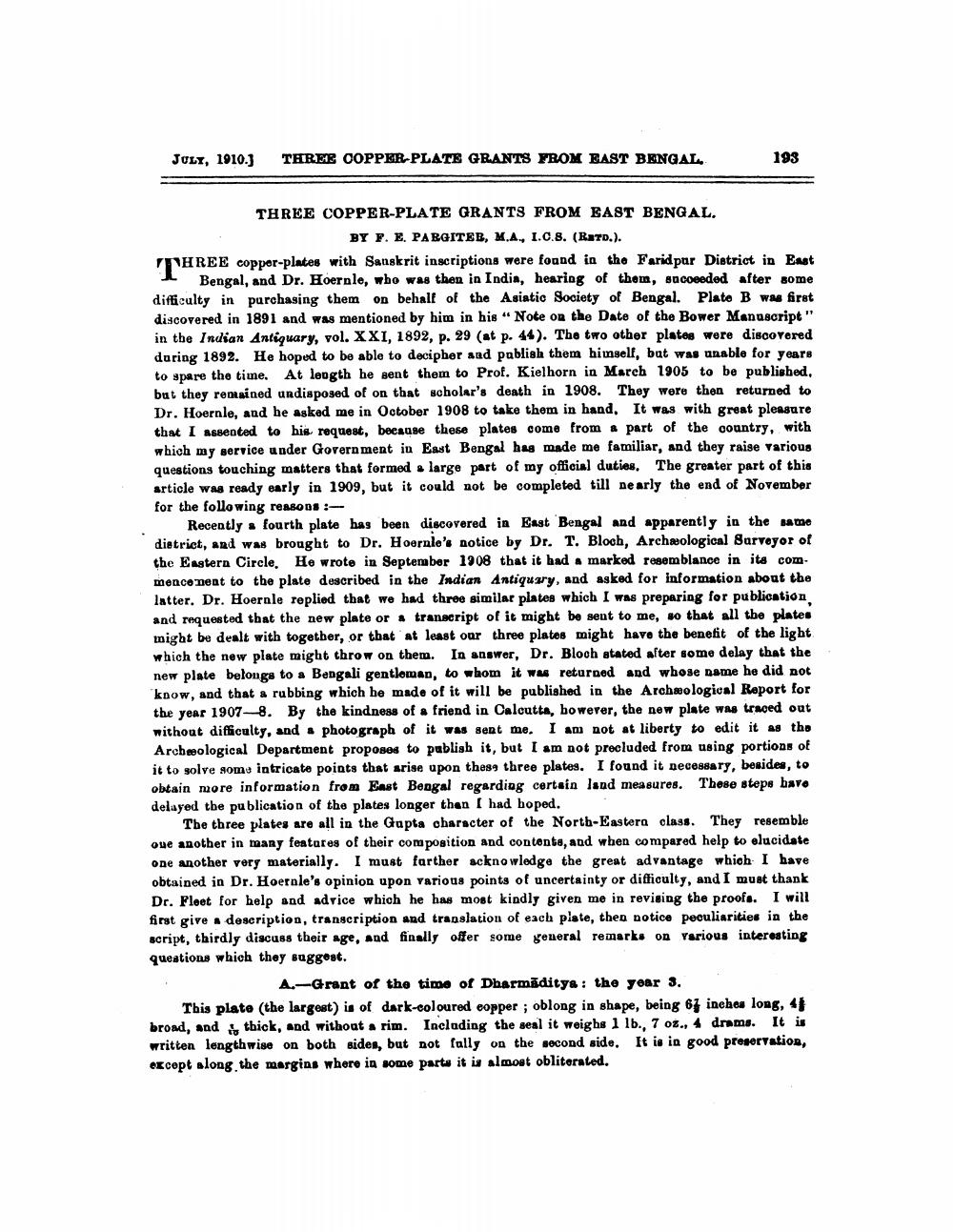________________
JULY, 1910.)
THREE OOPPER-PLATE GRANTS YBOM BAST BENGAL
193
THREE COPPER-PLATE GRANTS FROM EAST BENGAL.
BY P. E. PABGITER, M.A., 1.0.8. (Ratp.). T HREE copper-plates with Sanskrit inscriptions were found in the Faridpur District in East
1 Bengal, and Dr. Hoernle, who was then in India, hearing of them, succeeded after some difficulty in purchasing them on behalf of the Asiatic Society of Bengal Plate B was first discovered in 1891 and was mentioned by him in his “Note on the Date of the Bower Manuscript" in the Indian Antiquary, vol. XXI, 1892, p. 29 (at p. 44). The two other plates were discovered during 1892. He hoped to be able to decipher and pablish them himself, but was unable for years to spare the time. At length he sent them to Prof. Kielhorn in March 1905 to be published, but they remained undisposed of on that scholar's death in 1908. They were then returned to Dr. Hoernle, and he asked me in October 1908 to take them in hand. It was with great pleasure that I assented to his request, because these plates come from a part of the country, with which my service under Government in East Bengal has made me familiar, and they raise various questions touching matters that formed a large part of my official duties. The greater part of this article was ready early in 1909, but it could not be completed till nearly the end of November for the following reasons :
Recently fourth plate has been discovered in East Bengal and apparently in the same dietrict, and was brought to Dr. Hoernle's notice by Dr. T. Bloch, Archeological Surveyor of the Eastern Circle. He wrote in September 1908 that it had a marked resemblance in its com mence nent to the plate described in the Indian Antiquary, and asked for information about the latter. Dr. Hoernle replied that we had three similar plates which I was preparing for publication, and requested that the new plate or a transcript of it might be sent to me, so that all the plates might be dealt with together, or that at least our three plates might have the benefit of the light which the new plate might throw on them. In answer, Dr. Blooh stated after some delay that the new plate belongs to a Bengali gentleman, to whom it was returned and whose name he did not know, and that a rubbing which he made of it will be published in the Archæological Report for the year 1907–8. By the kindness of a friend in Calcutta, bowerer, the new plate was traced out without difficulty, and photograph of it was sent me. I am not at liberty to edit it as tho Archeological Department proposes to publish it, but I am not precluded from using portions of it to solve som, intricate points that arise upon these three plates. I found it necessary, besides, to obtain more information from East Bengal regarding certain land measures. These steps bavo delayed the publication of the plates longer than I had boped.
The three plates are all in the Gapta character of the North-Eastera class. They resemble oue another in many featares of their composition and contents, and when compared help to elucidate one another very materially. I must farther acknowledge the great advantage which I have obtained in Dr. Hoernle's opinion upon various points of uncertainty or difficulty, and I must thank Dr. Fleet for help and advice which he has most kindly given me in revising the proofs. I will first give a description, transcription and translation of each plate, theo notice peculiarities in the script, thirdly discuss their age, and finally offer some general remarks on various interesting questions which they suggest.
A.--Grant of the time of Dharmiditya : the year 3. This plate (the largest) is of dark-coloured copper ; oblong in shape, being 67 inehea long, 41 broad, and thick, and without a rim. Including the seal it weighs 1 lb., 7 03., 4 drams. It is written lengthwise on both sides, but not fally on the second side. It is in good preservation, except along the margins where in some parts it is almost obliterated.




